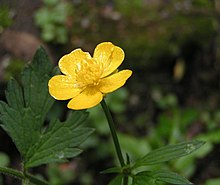| Ranunculus repens | |
|---|---|

| |
| Conservation status | |
 Least Concern (IUCN 3.1) | |
| Scientific classification | |
| Kingdom: | Plantae |
| Clade: | Tracheophytes |
| Clade: | Angiosperms |
| Clade: | Eudicots |
| Order: | Ranunculales |
| Family: | Ranunculaceae |
| Genus: | Ranunculus |
| Species: | R. repens |
| Binomial name | |
| Ranunculus repens L. | |
Ranunculus repens, the creeping buttercup, is a flowering plant in the buttercup family Ranunculaceae, native to Europe, Asia and northwestern Africa. It is also called creeping crowfoot and (along with restharrow) sitfast.
Description
It is a herbaceous, stoloniferous perennial plant growing to 50 cm (20 in) tall. It has both prostrate running stems, which produce roots and new plants at the nodes, and more or less erect flowering stems. The basal leaves are compound, borne on a 4–20 cm (1+1⁄2–8 in) long petiole and divided into three broad leaflets 1.5–8 cm (1⁄2–3+1⁄4 in) long, shallowly to deeply lobed, each of which is stalked, distinguishing the species from Ranunculus acris in which the terminal leaflet is sessile. The leaves higher on the stems are smaller, with narrower leaflets and may be simple and lanceolate. Both the stems and the leaves are finely hairy. The flowers are golden yellow, glossy, and 2–3 cm (3⁄4–1+1⁄4 in) diameter, usually with five petals, and the flower stem is finely grooved. The gloss is caused by the smooth upper surface of the petal that acts like a mirror; the gloss aids in attracting pollinating insects and thermoregulation of the flower's reproductive organs. The fruit is a cluster of achenes 2.5–4 mm (3⁄32–5⁄32 in) long. Creeping buttercup has three-lobed dark green, white-spotted leaves that grow out of the node. It grows in fields and pastures and prefers wet soil.
Habitat
It is a very common weed of agricultural land and gardens, spreading quickly by its rooting stolons and resisting removal with a deeply anchored filamentous root ball. In Ireland: very common in damp places, ditches and flooded areas.
Cultivation and uses
Creeping buttercup was sold in many parts of the world as an ornamental plant, and has now become an invasive species in many parts of the world.
Like most buttercups, Ranunculus repens is poisonous, although these poisons are lost when dried with hay. The taste of buttercups is acrid, so cattle avoid eating them. The plants then take advantage of the cropped ground around them to spread their stolons. Creeping buttercup also is spread through the transportation of hay. Contact with the sap of the plant can cause skin blistering.
Etymology
Ranunculus is a diminutive of 'rana', meaning 'little frog'. This name is in reference to the amphibious habitat of many Ranunculus species.
Repens means 'creeping' or 'stoloniferous'.
References
- Lansdown, R.V. (2011). "Ranunculus repens (Europe assessment)". IUCN Red List of Threatened Species. 2011: e.T164044A5726616. Retrieved 4 October 2023.
- Ranunculus repens L. Flora Europaea
- ^ "Ranunculus repens". Germplasm Resources Information Network. Agricultural Research Service, United States Department of Agriculture. Retrieved 24 December 2017.
- Oxford English Dictionary entry for "Sit-fast":2. Sc.a. The plants restharrow and creeping crowfoot. 1808 JAMIESON, Sitfasts, restharrow. 1825 {emem} Suppl., Sitfast, Creeping Crowfoot, Ranunculus Repens.
- ^ Parnell, P. and Curtis, T. (2012). Webb's An Irish Flora. Cork University Press. ISBN 978-185918-4783
- Van Der Kooi, C. J.; Elzenga, J.T.M.; Dijksterhuis, J.; Stavenga, D.G. (2017). "Functional optics of glossy buttercup flowers". Journal of the Royal Society Interface. 14 (127): 20160933. doi:10.1098/rsif.2016.0933. PMC 5332578. PMID 28228540.
- Buttercups focus light to heat their flowers and attract insects New Scientist 25 February 2017
- Blamey, M. & Grey-Wilson, C. (1989). Flora of Britain and Northern Europe. ISBN 0-340-40170-2
- Flora of NW Europe: Ranunculus repens
- Hackney, P. (1992). Stewart and Corry's Flora of the North-east of Ireland. Third Edition. Institute of Irish Studies and The Queen's University of Belfast ISBN 0-85389-446-9.
- Ranunculus repens. Plants for a Future
- ^ Gledhill, David (2008). "The Names of Plants". Cambridge University Press. pp. 326, 328. ISBN 9780521685535
External links
 Media related to Ranunculus repens at Wikimedia Commons
Media related to Ranunculus repens at Wikimedia Commons
| Taxon identifiers | |
|---|---|
| Ranunculus repens |
|